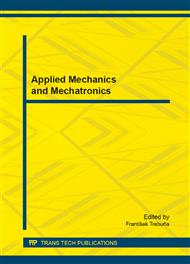p.496
p.501
p.506
p.511
p.519
p.529
p.536
p.544
p.548
Simulation and Analysis of Defect Distribution in Passenger Car Tire under Dynamic Loading
Abstract:
The paper deals with experimental simulation measuring and the analysis of defect distribution in passenger car tire under dynamic loading. The main reason for detection of defect extension is to recognize an influence of closed air, small bubbles, separations in tire and it is mainly connected with its quality during its service in a vehicle in terms of road safety. This analysis should help constructors to solve critical conditions in tire casing, whether material selection and individual components proportions are suitable and fit or even the whole construction of tire casing is suitable. The reason for detection of internal defects in tire casing is to avoid the wear of those tires which already contain some internal defects and already recognised separations, which could propagate during the movement of vehicles. This is closely connected with the occurrence of tire destruction and the main purpose is to prevent its critical status and later vehicle crash and human life menace.
Info:
Periodical:
Pages:
544-547
Citation:
Online since:
August 2014
Authors:
Keywords:
Price:
Сopyright:
© 2014 Trans Tech Publications Ltd. All Rights Reserved
Share:
Citation:


